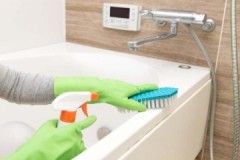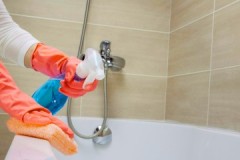How and with what to gently and effectively clean an acrylic bathtub at home?
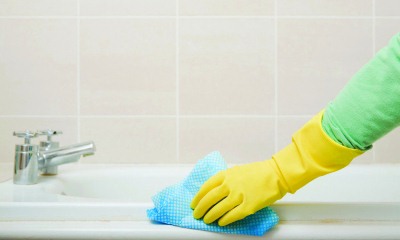 The acrylic bathtub is lightweight, inexpensive, and practical. However, like any other plumbing, it tends to get dirty.
The acrylic bathtub is lightweight, inexpensive, and practical. However, like any other plumbing, it tends to get dirty.
You need to take care of it correctly, choosing gentle detergents.
Read about how to clean an acrylic bathtub from rust, soap and limescale, yellowness and at the same time not damage it, read the article.
Content
Improvised means
To clean an acrylic bath, you don't always need to buy expensive formulations. You can remove simple dirt with the help of available tools.
Lemon acid
Citric acid does an excellent job of limescale. Use it as follows:
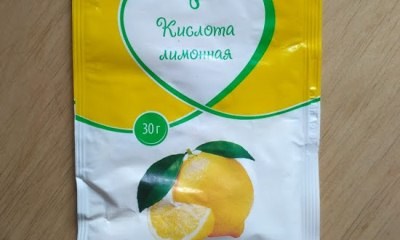 The bath must be filled with hot water. The maximum allowable temperature is 60 degrees.
The bath must be filled with hot water. The maximum allowable temperature is 60 degrees.- Pour 2 sachets of acid into the water, mix to dissolve completely.
- Leave the agent to act for 2 hours.
- The bath is washed with clean water, the remains are removed with a dry cloth.
If the contamination is not extensive, then citric acid is dissolved in a glass of water and applied to the contamination with a sponge. After an hour, the solution is removed.
Toothpaste
Good whitening yellowness and removes rust toothpaste. Instructions for use:
- squeeze a small amount of paste onto the stain;
- distribute it over the surface, leave for 15 minutes;
- gently rub the bath with an old soft-bristled toothbrush;
- wash off the paste with water.
Ammonia
Dark and yellow stains can be eliminated with ammonia and hydrogen peroxide.
Use the composition as follows:
- Alcohol and peroxide are mixed in equal proportions.
- Soak a sponge in the solution.
- Apply the composition to the dirty areas and rub gently with a soft brush.
- Rinse the surface with clean water.
Soda
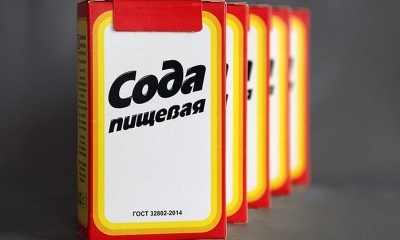 You can remove limescale and soap deposits with a soda solution. Mode of application:
You can remove limescale and soap deposits with a soda solution. Mode of application:
- dilute soda with clean water until a slurry is formed;
- apply it to contaminated areas;
- leave for 15 minutes;
- rub with a sponge, rinse with water.
Apple vinegar
Apple cider vinegar is a safe way to remove light stains. Use it as follows:
- Saturate the sponge with vinegar.
- Apply it to the contaminated area.
- Leave to bleach for 15 minutes.
- Wash off the product with warm water.
Special formulations
To clean the acrylic bath, you can use the following store products:
Cinderella emulsion
This compound is intended for processing acrylic... After its application, a protective film forms on the surface, and the bath acquires a characteristic shine. The composition is based on anionic and nonionic surfactants.
Shake the bottle thoroughly before use. To remove stubborn dirt, the agent is left on the surface for 10 minutes. The price of the bottle is 80 rubles.
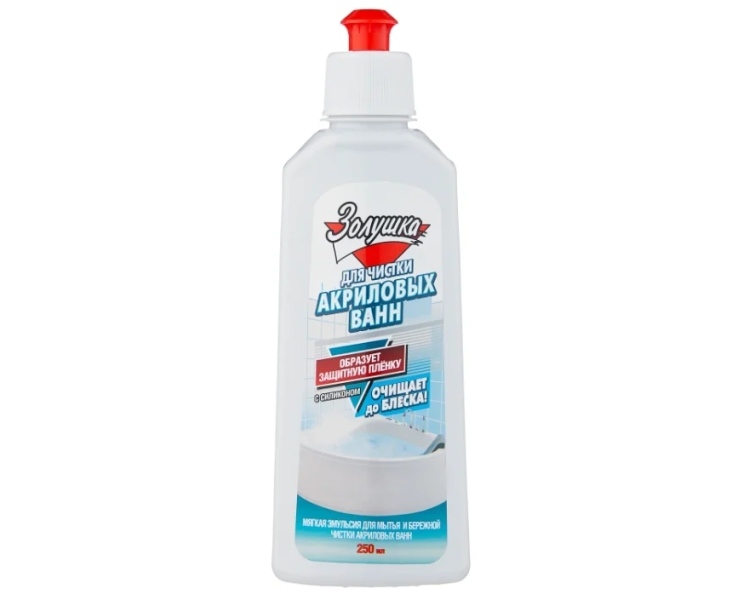
Spray Unicum
It can be used to combat:
- rust,
- mold,
- soapy and limescale.
The use of the product gives the bath its original shine and leaves behind a protective layer. Price - 200 rubles.
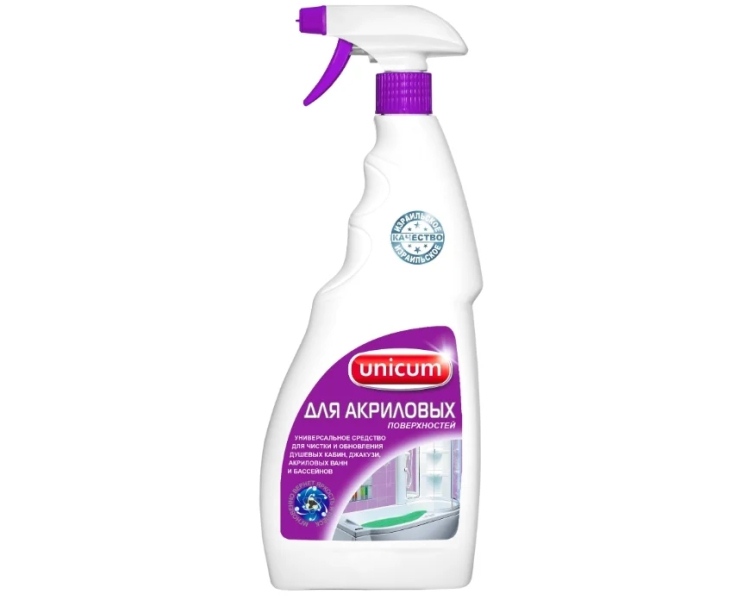
Sanfor gel Acrylite Professional
This gel effectively removes rust, limescale and soap deposits, copes with unpleasant odors. Its formula is fortified with citric acid and surfactants.
The product has an antibacterial effect. Price - 150 rubles.
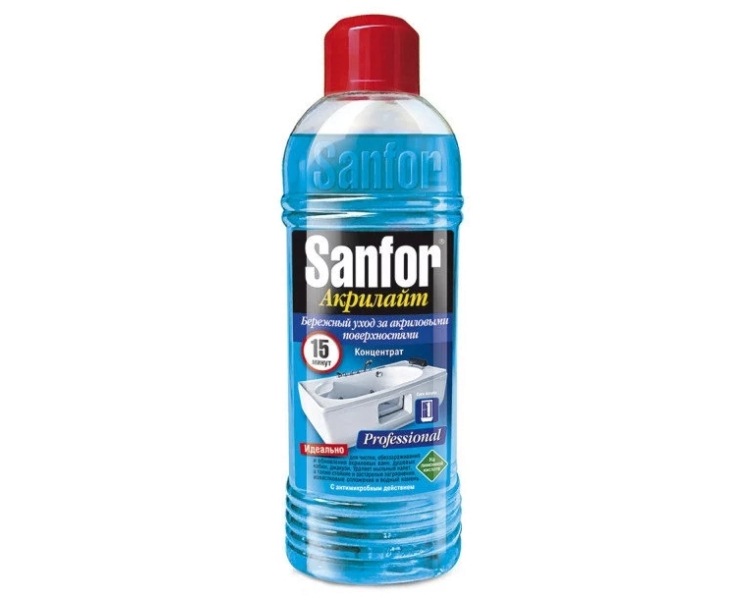
The listed formulations can be purchased in retail stores, in the departments with household chemicals, as well as in online markets.
Video about the use of Sanelit cleaning agent for cleaning acrylic bathtubs:
Can brushes be used?
To remove dirt from an acrylic bath you can use brushes, but they must have a soft bristle.
Features of removing various contaminants
Different formulations must be used depending on the type of contamination. This improves cleaning efficiency.
Limescale
You can get rid of limescale with citric or acetic acid.... For processing, do not use too concentrated a solution. If the layer is old, then 1 glass of water will require 1 sachet of citric acid or 2 tablespoons of vinegar.
The product is applied to the stains and left for 20 minutes. During this time, contamination must be periodically moistened. Wash off the product with warm water. Repeat the procedure if necessary. If it was decided to use household chemicals, then it should contain citric or oxalic acid.
Soapy
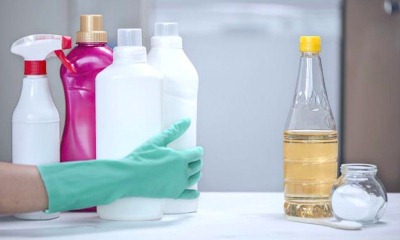 You can get rid of soap deposits with baking soda, vinegar and water. They are used as follows:
You can get rid of soap deposits with baking soda, vinegar and water. They are used as follows:
- Soda is diluted with water to a paste and applied to stains.
- In a spray bottle, table vinegar and water are mixed in equal proportions.
- The resulting solution is applied to dried soda and rubbed with a soft brush.
- Wash off the product with clean water.
If you do not want to use the tools at hand, then you can purchase any universal composition that is designed to care for acrylic baths. All of them are able to remove soap deposits.
Mold
Hydrogen peroxide helps fight mold. Use it as follows:
- peroxide is impregnated with a sponge;
- it treats areas on which mold has appeared;
- leave for an hour;
- re-processing;
- wash off the composition with hot water.
Yellowness
To get rid of yellowness, you can use the following tools:
- A mixture of soda ash and baking soda. They are combined in equal proportions, applied to the yellow areas and poured with table vinegar. After an hour, the product is washed off.
- Ammonia.It will take at least half an hour to have an impact. All this time the bathroom door should be open.
- A mixture of washing powder with bleach in the composition and grated laundry soap. The components are diluted with water to a mushy state and applied to yellowed areas for an hour.
- Hydrogen peroxide. It has strong whitening properties.
Yellow rust spots
 You can get rid of rust with the help of Coca-Cola. This unique product will not damage acrylic, but it will perfectly dissolve rust.
You can get rid of rust with the help of Coca-Cola. This unique product will not damage acrylic, but it will perfectly dissolve rust.
Use it as follows:
- the bath is rinsed with water and dried;
- apply cola to a rag and apply it in the form of a compress to rusty spots;
- as the rag dries, it needs to be moistened;
- after 3 hours, the bath is rinsed with clean water.
During this time, the rust will dissolve and easily wash off the treated surface.
What can't be used and why?
For washing an acrylic bath you can not use tools such as:
- Acetone. It can lead to thinning of the acrylic layer and rapid wear of the bath.
- Abrasive substances. This applies not only to cleaning powders, but also to regular soda. It can only be used diluted. The use of abrasive compounds contributes to the appearance of scratches.
- Highly concentrated acids such as vinegar essence.
- Paint thinners, gasoline.
- Boiling water. To prevent the acrylic from cracking, the water temperature should not exceed 60 degrees.
- Chlorine and cleaning agents based on it. Its use leads to the formation of pores, which shortens the life of the product.
- Formaldehyde. These substances are not only toxic, but also completely incompatible with acrylic.
Helpful information
Care Tips behind the acrylic bath:
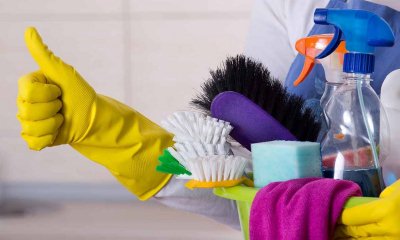 When using any chemicals, rinse them with cool, not hot, water. At high temperatures, they increase their activity and can cause damage to the acrylic.
When using any chemicals, rinse them with cool, not hot, water. At high temperatures, they increase their activity and can cause damage to the acrylic.- Before using the detergent, you need to carefully study its composition. It should not contain components that can destroy acrylic.
- You cannot mix several compounds at once, if this is not indicated in the recipe. Multi-component substances can accelerate product deterioration.
- When washing the bath, you need to take care of the safety of the skin of your hands, protecting them with gloves.
All the most important and useful information about bathroom cleaning is collected in this section of the site.
Conclusion
You can wash the acrylic bathtub with the help of available tools and specialized household chemicals. The stronger the pollution, the more effort will have to be made. In order for the bath to last as long as possible, the use of prohibited caustic substances and abrasive compounds should be avoided.

